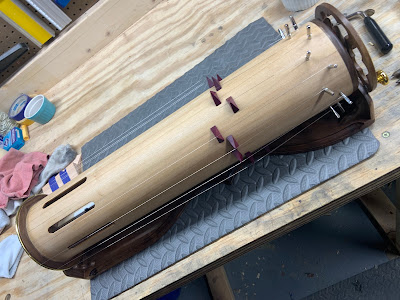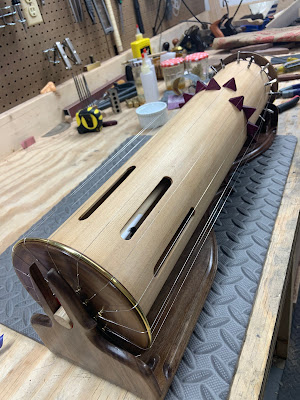In early November of this year, over a month ago now, I finished the final assembly on the rotola, completing a design and fabrication project of more than three years. Whoot!
After making the bow and fitting the crank, there were some small details to add, the most involved of which was getting the instrument to rotate freely but not sloppily in its cradle by placing felt in the yokes supporting the axle and adjusting the play between the ends. I also cut a small walnut spacer, like a thick washer, to fit between the nut and the left yoke so as to keep the strings' anchor pins from scraping against the inside of the yoke. I then added thin felt to the outside of the nut spacer and to the surfaces on the inside of the right yoke, which would contact the face of the cap on the pinblock. Altogether, these cushions let the instrument rotate very comfortably and silently.
Next step was to string the instrument. Following protocol for stringing a gayageum, the Korean zither-like instrument (and its Japanese and Chinese cousins) which was one of the main inspirations for the rotola, I initially attached and roughly tuned the strings without the bridges. The idea here was to keep the tension across the instrument as even as possible, which is especially important in a cylindrical instrument like the rotola. Imagine a radio tower, which is essentially a rigid frame held in place by wires pulling radially around it: if the wires are not pulling equally, the tower could lean, bend, or even break. Similarly, the longitudinal tension of the rotola's strings should be at least roughly even so as to reduce the risk of warping or, less likely but more problematically, cracking or breaking the instrument.
With the strings on, I had to find what tension would be ideal. This was tricky -- and I'm still unsure of the optimum -- as it is determined by trade-offs between desired pitch, length of the string, gage (diameter) of the string, and stiffness of the string. My initial aurelization for this instrument was as a deep drone, but this prototype is relatively small and therefore necessarily will have a higher base pitch. Since I had determined the material and gage of my strings based on the length and pitch of the strings on the bowed psaltery, an acoustically similar instrument, its pitch could not be lower than middle C. Material (steel) and gage (.012") were thus determined. Length of the string was constrained, of course, by the length of the instrument, but also by another factor which I had not considered previously: in order for the bridges to transfer their energy most effectively to the body of the rotola, they had to be tall enough for the tensioned string to exert a sufficient down-force. This, in turn adds tension to the string and, as the bridge is moved toward the one end (in order to maximize the length of the resonating section of string and to find its lowest pitch), this tension increases, such that within a certain proximity to the end, continuing to move the bridge begins counterintuitively to raise the pitch. Thus, there is a range, surprisingly wide (couple of inches on the rotola) within which the pitch of the string remains roughly stable, despite moving the bridge one way or the other. This range takes up length of string and so the maximum resonating length of the string ends up being much shorter -- and thus the minimum pitch higher -- than I had expected.
To illustrate, here is a schematic of the setup (not to scale). The string runs between the nut and the tuning pin, across the bridge. The bend in the string created by the bridge presses the bridge down against the soundboard, which allows it to transfer the vibrations of the resonating section of the string into the soundboard. 
The end result of this was, as concluded above, that the lowest playable pitch of the instrument was much higher than I had intended because the length of the resonating section turned out to be much shorter than I had counted on. After much experimentation, I finally settled at F above middle C (F3 or F4, depending on the system you're using).
The images below show the final assembled instrument and how it is bowed:
Another issue was that, as can be seen in the above pix, the placement of the bridges was not as consistent from string to string as I expected; they looked like a set of bad teeth. I had anticipated that the bridges would alternate closer to and further from the nut in parallel with the tuning pins, as these are staggered for efficiency of space. However, try as I might to tune the strings without the bridges, once I put the bridges in place to produce an F, their location varied greatly; I still don't know why. This was not a great problem initially, but as the next -- and most serious -- issue developed, it became at least potentially more relevant.
The most significant and, indeed, design-changing issue was wolfing. Bowed-string instrument players are probably most familiar with this phenomenon, although I believe all musical instruments are subject to it: a string, or more commonly a specific note, refuses to sound or sounds very poorly, instead making a kind of choking sound. After much experimentation, I discovered that every string attached to a left tuning pin -- those closer to the nut -- wolfed at least a bit. In the end, six of them were so bad I had to remove them, leaving the rotola now with ten strings in a pattern of two groups of three strings with two sets of single strings in between each (3-1-1-3-1-1). The two groups of three each have a string with a left tuning pin in the middle, but, for whatever reason, their wolf is very mild and not problematic; it may be noteworthy that these two are on opposite sides of the instrument.
My working hypothesis for what is causing the wolfing is based on what I know causes wolfing in violin-family instruments: due to the unique properties of the wood from which an instrument is constructed and the minute imperfections of its construction, any given instrument has frequencies at which it will resonate more readily than others. (This is not desirable; keeping the frequency response of an instrument as even as possible across the audio spectrum is the goal of any instrument maker.) These same imperfections will also necessarily make an instrument idiosyncratically unresponsive at other frequencies; this is the wolf.
I believe that, in the case of the rotola, this effect is exacerbated by its cylindrical construction. In a violin, guitar, or banjo, the interface between the bridge and the soundboard is concentrated in one place; all soundwaves travel through that spot and propagate freely out across the soundbox from there. The rotola's bridges, in contrast, are concentrated in a ring around the waist of the cylinder and at least half of the instrument's strings are being played at once; it is plausible that these factors combine to significantly increase the likelihood that a given bridge's vibrations will be interfered with by waves from another.
Another hypothesis is that the shallow break angle of each string over the bridge (i.e., the relatively low height of the bridges relative to the pins and nut) along with a relatively low string tension means that the downward pressure of the bridges onto the soundboards is weak, making it easier for the two to lose contact as they vibrate together, in turn increasing the chance that they could vibrate at different frequencies and interfere with each other.
As to why it is just the left-side pinned strings that do this, it could be that the wolf has nothing to do with the placement of the bridges per se, but rather an inharmonicity between the length of the shorter strings and the resonating body. Whatever the case, removing most of the offending strings seems to have addressed the issue; it may be that a given bridge needs a certain minimum available space on the sounding body in order to resonate.
That is it for this project and related posts. I do have ideas about the next iteration of rotola: I want it to be longer, such that the resonating length of the string can produce at least a C two octaves below middle C (C1 or C2). As I said, a deep drone was what I originally had in mind. With the working hypothesis that each bridge needs a certain minimum amount of real estate, a larger diameter seems useful (indeed, I recently discovered a similar instrument which is much larger and grants each string much more room between itself and the next), a greater circumference seems useful, too. Also, I plan to increase the break angle at the bridge, increasing the contact pressure there. Additionally, since I had so much trouble steam bending the curve of the cylinder into the sections of soundboard, I am also thinking about carving the sections instead. Only the future will reveal...
Thanks for coming along on this journey with me!

























































